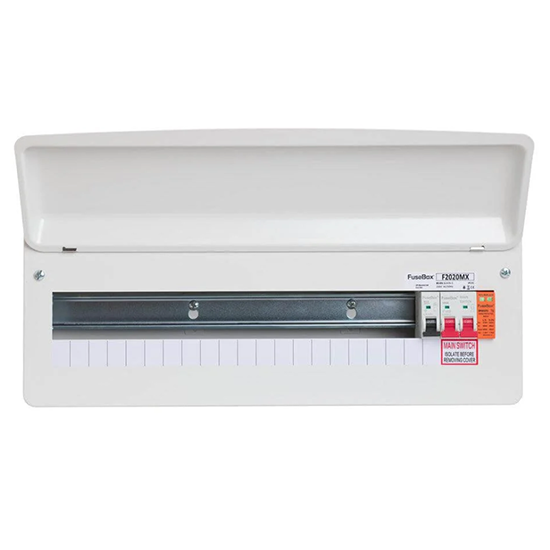The Function of Customer Units in Effective Power Management Systems
Customer devices are integral to effective energy management systems, serving as the main circulation factors for electrical power within structures. By incorporating breaker, they safeguard circuits from potential overloads, therefore keeping safety and avoiding comprehensive outages. The development of smart innovations has further boosted their capability, enabling real-time data surveillance and nuanced power intake evaluation. This integration not just maximizes energy usage but additionally facilitates the unification of sustainable energy sources, consequently advertising sustainable methods. How, then, do these innovations convert to substantial advantages in everyday power management?
Recognizing Consumer Systems

Comprehending the role of consumer devices starts with identifying their crucial function in securing electric systems. By separating faults within certain circuits, customer units prevent widespread failures and prospective fire hazards. This isolation is achieved with using breaker that trip or fuses that impact when a mistake is spotted, thereby cutting off the electrical circulation to the affected circuit.
Moreover, consumer devices help with the organized distribution of power, boosting the performance of power use. They allow for the methodical monitoring of electric loads, which can be particularly crucial in commercial and industrial settings where need can change substantially. Properly conserved customer units add to the longevity of electrical systems and assist in lessening downtime brought on by electrical failures, eventually sustaining the seamless procedure of energy-dependent centers.
Smart Technologies Integration

A key advantage of smart consumer systems is their capacity to take advantage of progressed algorithms and machine understanding for anticipating analytics. This enables preemptive changes based on use patterns, weather report, and various other variables, significantly increasing overall effectiveness. In addition, smart customer devices promote need feedback programs, where energy usage can be dynamically adjusted throughout peak durations to maintain the grid and lower prices.
The combination of renewable resource sources, such as solar and wind, is also streamlined through smart customer systems. By wisely handling the intermittency of these resources, these devices make certain a well balanced and reputable energy supply. Furthermore, wise customer units enhance customer interaction by supplying thorough insights and push-button control capabilities through mobile applications, promoting an extra aggressive technique to power conservation and sustainability.
Monitoring Power Usage
Structure on the capabilities of wise modern technologies assimilation, keeping track of power consumption comes to be an essential emphasis within power administration systems. By leveraging sophisticated metering facilities (AMI), real-time data on power usage can be accumulated at granular levels, giving important insights right into consumption patterns and peak need durations.
Smart meters and Net of Points (IoT) tools play a crucial role in this surveillance procedure. These devices can track power usage in real-time, transferring data to centralized systems for analysis.
The combination of these technologies not only site empowers customers with comprehensive information concerning their power use yet additionally supports energy service providers in managing lots circulation more efficiently. Inevitably, continuous and specific monitoring is vital for attaining energy performance, price financial savings, and sustainability objectives within power administration systems.
Optimizing Device Usage

One reliable technique includes determining optimal and off-peak hours to change energy-intensive tasks, such as laundry or dishwashing, to times when power need is reduced. This not only reduces strain on the grid yet also utilizes on reduced power tariffs. Furthermore, incorporating website here machine understanding formulas permits predictive upkeep, ensuring appliances operate at optimum efficiency and lengthening their lifespan.
Power administration systems can likewise integrate user-specific preferences and behaviors to customize appliance usage timetables. Clever illumination systems can adjust illumination based on tenancy and all-natural light availability, while Cooling and heating systems can keep convenience degrees without too much energy use.
Supporting Sustainability
Advertising sustainability within power administration systems entails not only enhancing effectiveness however also fostering ecologically accountable techniques. Customer units are integral to this process, as they supply real-time information and control systems that make it possible for individuals to check and reduce their power consumption. By leveraging sophisticated modern technologies, customer units can recognize energy-saving chances and promote the integration of renewable power sources like solar and wind power.
One crucial facet of advertising sustainability is enlightening consumers on the advantages of responsible power use. Through thorough understandings given by customer devices, individuals can make educated choices that lessen their carbon impact. These systems can recommend optimal times for running high-energy devices based on grid need and eco-friendly energy schedule, thereby lowering reliance on fossil gas.
Additionally, customer devices sustain the adoption of smart grid technologies, which enhance the total performance and dependability of power distribution. By enabling two-way communication between consumers and energy carriers, these systems can dynamically adapt to energy demands, minimizing waste and advertising making use of lasting energy practices.
Conclusion
Customer systems, as indispensable parts of energy monitoring systems, considerably boost electric security and performance within buildings via circuit security and clever innovation combination. Real-time data monitoring and analysis assisted in by these systems enhance energy intake and device use. Furthermore, the consolidation of renewable resource sources promotes sustainable techniques, adding to lowered overall energy consumption and lower carbon impacts. Subsequently, customer units play an essential role ahead of time both energy effectiveness and environmental sustainability.
Advances in smart innovations have transformed the abilities of power monitoring systems, specifically via the combination of smart customer systems.Building on the capacities of smart modern technologies integration, keeping track of energy consumption ends up being a vital focus within energy management systems.Reliable appliance usage optimization is an important component of energy administration systems, aiming to boost efficiency and lower unnecessary power consumption.Customer systems, as integral elements of power monitoring systems, significantly improve electrical safety click for more and efficiency within structures via circuit defense and wise innovation assimilation. Additionally, the consolidation of renewable energy resources advertises sustainable methods, adding to lowered overall power usage and lower carbon impacts.